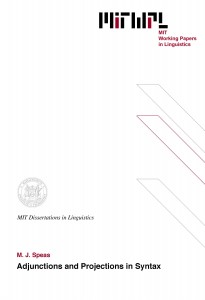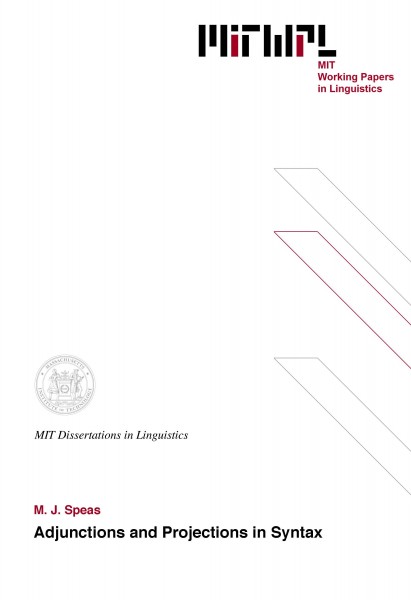Adjunctions and Projections in Syntax
M. J. Speas, 1986
This dissertation is a study of the principle which determine well-formed underlying structures. In the first Chapter, a theory of projection of syntactic configurations from the lexicon is presented, in which the restrictions on underlying domination relations encoded in the X-bar schem are shown to be derivable from general principles. The proposal is based on the theory of lexical representations of Higginbotham (1985, 1986), in which words of all lexical categories (N, V, A, P) are though to have a "theta grid" as part of their lexical entry. It is argued that the relations which hold among these grids are sufficient to give all the information that is needed to deduce the domination relations which result when these lexical entries are projected from the lexicon. Lexical items which lack theta grids, i.e. those of the non-lexical or "functional" categories (INFL, COMP, DETERMINER), are argued to differ significantly from lexical categories in the way that they project. The first Chapter concludes with a discussion of the properties of adjunction constructions, which points out that the claims of May (1985) about domination relations in LF adjunction structures lead to the conclusion that such structures are always three-dimensional.
The second chapter deals with linguistic variations at the level of underlying structure, exploring the parameters which have come to be associated with the term "configurationality". It is pointed out that the projection of lexical selection requirements is potentially open to variation in both the type of structure projected and the types of elements which may fill projected positions. It is proposed that these two types of variation ought to be kept distinct.
The diverse data which have been adduced as evidence for the first type of variation, i.e., variation in the structural distinction between subject and object, are brough together in order to clarify the issue. While it is often assumed that "nonconfigurational" languages are those with "flat" structures, the data actually seem to call for some sort of dual representation, where one of the representations is universily asymmetric. Thus, the evidence suggests that the structures projected from lexical entries are at the most abstract level immune from variation.
The categorial realization of lexical requirements, on the other hand, is subject to variation. It is proposed in this chapter that languages vary as to whether theta grid positions may be discharged in the morphology (given a particular view of the Mophological Component). Under this proposal, in certain languages, theta roles are discharged by morphemes; nonetheless overt nominals in such languages are in argument positions, and form a CHAIN with the theta-role bearer. Standard syntactic tests indicate that this view makes the correct predictions.
In Chapter 3, the morphology of one such language, Navajo, is examined in detail. The status of Navajo prefixes which mark subject and object agreement is considered. Arguments are given that these agreement prefixes must be infixes, that is, that they must be inserted into a discontinuous lexical item. The result is a morphological model in which the pronominal prefixes are available to discharge theta positions.
It is then shown that the available syntactic evidence motivates an analysis of Navajo in which overt nominals are in argument, not adjunct, positions. This is just as predicted by the parameter proposed in the previous Chapter.
The syntactic facts which have led previous researchers to classify Navajo as nonconfigurational are considered in Chapter 4. These facts involve some curious restrictions on the interpretation of null pronominals, which seem to violate binding conditions. It is claimed that the data reveal a parallelism restriction on the assignment of Grammatical Relations, which is best handled if the relevant constructions are treated as Across-the Board (ATB) constructions.
After an ATB account of the Navajo facts is presented in general terms, the question of the status of these representations in grammatical theory is addressed. It turns out that all of the constructions for which an ATB account has been proposed share certain properties with adjunction constructions. In particular, they involve structures which are formed by adding to the structure projected from lexical entries. It is suggested that parallelism effects may occur whenever the link between two sub-parts of a structure does not follow from the principles of projection from the lexicon.
Thesis supervisor: Kenneth Locke Hale
Title: Ferrari P. Ward Professor of Linguistics
Table of Contents
Introduction 9
0.1 Modularity: subsystems, levels and components 10
0.2 Internal and external licensing conditions 13
0.2.1 Relating the levels 16
0.3 D-structure 17
0.3.1 From phrase structure rules to licensing conditions 17
0.3.1.1 X-bar theory 20
0.3.1.2 INFL and the headedness of S 21
0.3.1.3 The specifier and head of S" 25
0.3.1.4 The theta criterion 26
0.3.1.5 Adjuncts 27
0.4 The relevance of D-structure to other syntactic levels 28
0.4.1 The projection principle revisited 28
0.4.2 Barriers and L-marking 31
0.4.3 Complete functional complexes as binding domains 32
0.4.4 Theta positions in CHAINS 33
0.5 Parametric variation 34
0.6 Overview of the thesis 36
Chapter 1 Projection from the lexicon 41
1.1 Background 42
1.1.1 Phrase markers 42
1.1.1.1 Node admissibility conditions 43
1.1.1.2 Reduced phrase markers 52
1.1.2 Thematic grids 54
1.1.3 Discharge of thematic positions 60
1.1.3.1 Theta-marking 62
1.1.3.2 Theta-binding 65
1.1.3.3 Theta-identification 66
1.1.3.4 Autonymous theta marking 67
1.2 Local relations and constituency 69
1.2.1 The role of the X" schema 72
1.2.2 Grid relations 76
1.2.3 Conclusions 88
1.3 Functional categories 91
1.3.1 The structure of IP and DP 97
1.3.2 Function features 97
1.3.3 Deriving the surface order 101
1.3.4 The Spec position 104
1.3.5 Some consequences of the proposal 107
1.4 Adjunction constructions 115
1.5 The X" schema revisited 117
Chapter 2 Configurationality: variation in the projection of structure 125
2.1 What is a "nonconfigurational" language? 125
2.1.1 A digression about word order 128
2.2 Sources of D-structure variation 132
2.2.1 X" theory and the projection principle 133
2.2.2 The dual representation hypothesis 135
2.3 Variation in structure 139
2.3.1 Subject/object asymmetries 140
2.3.2 Explaining structural variation 152
2.3.3 The structure of Walpiri 155
2.3.4 The structure of Japanese 161
2.3.5 The structure of Malayalam 168
2.3.6 The structure of Hungarian 178
2.3.7 VSO languages 190
2.3.8 Summary of evidence 193
2.4 Variation in categorial realization: on pronominal argument
languages 195
2.4.1 Jelinek"s proposal 195
2.4.2 Some problems 198
2.4.3 The saturation parameter 208
2.4.4 Consequences of the saturation parameter 213
Chapter 3 Navajo nominals and pronominal infixes 218
3.1 Navajo infixes 219
3.1.1 Navajo verb morphology 222
3.1.2 Interrupted synthesis 223
3.1.3 Three arguments for an infixation account of Navajo verb
formation 227
3.1.3.1 Lexical relatedness 227
3.1.3.2 Mode choice and Da-shift 231
3.1.3.3 Ni-absorption 243
3.1.3.4 Evidence for concatenative phonology 248
3.1.3.5 Summary 251
3.1.4 Infixation frames 253
3.2 Navajo overt nominals are in argument positions 260
3.3 Conclusion 266
Chapter 4 An Across-the-Board account of Navajo relative clauses 269
4.1 Introduction 269
4.2 Navajo sentence structure 273
4.2.1 Simple sentences 273
4.2.2 Relative clauses 277
4.3 Parallelism in relative clause constructions 279
4.4 An Across-the-Board treatment of Navajo relative clauses 291
4.5 On the inadequacy of a simple pro-drop account of Navajo 298
4.6 On mapping conventions 313
4.7 Formal properties of ATB representations 320
4.7.1 The coordinate structure constraint 320
4.7.2 Williams (1978) ATB format 322
4.7.3 Goodall (1984) Union of Phrase Markers 324
4.7.4 ATB effects in non-coordinate constructions 330
4.7.5 Other parallel constructions 333
4.7.5.1 Bella Coola 334
4.7.5.2 Hopi 338
4.7.6 The Navajo case 340
4.7.6.1 Base generation of parallel pronominals 341
4.7.6.2 LF extraction and parallel variables 344
4.7.6.3 Adjunction, embedding and generalized
transformations 347

